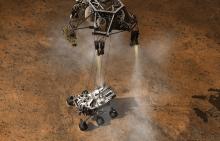The current delivery system for the Mars rovers was a combination of atmospheric entry heat shield, rigid parachute, and the last 5,000 retro-rockets kick in to provide the rover with a nice, gentle landing. Unfortunately, the single ton rovers are about the extent of this entry strategy’s payload. For a significantly heavier payload (like a 40 ton manned vehicle), other as-of-yet undeveloped technologies will be necessary. That’s not to say that NASA hasn’t developed some ideas.
The problem with parachutes is that Mars’ atmosphere is almost non-existent. A parachute needs to be incredibly large in order to create the necessary drag to slow an object in free-fall. Of course, the larger the parachute, the more weight and space it will take up en route. For a 40-ton payload the parachute would need to be, according to NASA’s co-chair of rover entry Michael Wright, the size of the Rose Bowl. Obviously, using parachutes to slow entry are not realistic. That in mind, NASA has been developing an Inflatable Aerodynamic Decelerator (IAD). The IAD would be a large saucer-shaped (I know, how cliché) device that would inflate nearly instantaneously when the entry vehicle hit the upper Martian atmosphere. The IAD would be made of a rigid, hardy material like Kevlar, which would withstand the extreme heat of entering Mars’ atmosphere.
However, a spacecraft’s entry is 1,500 mph, and an IAD will only shave off a portion of that speed. There will need to be further steps in re-entry to avoid crushing landing gear and astronauts when they finally “land”. For that, NASA is looking at supersonic retrorockets (sound like a 80’s pop band, right?). Because even with the IAD, the vehicle will be traveling faster than the speed of sound, it will be necessary to create propulsion that is stronger than the atmospheric blowback. Otherwise there’s a risk of shockwaves that could literally tear the vehicle apart. The rockets could be further calibrated to adjust propulsion to vehicle speed, allowing the vehicles to literally hover above the Martian surface and lower the actual payload to the ground safe and sound.
After developing all of this, and attempting to do it with time to launch an actual mission by 2032, we'll assume they’re also considering a way to bring the crew back.
